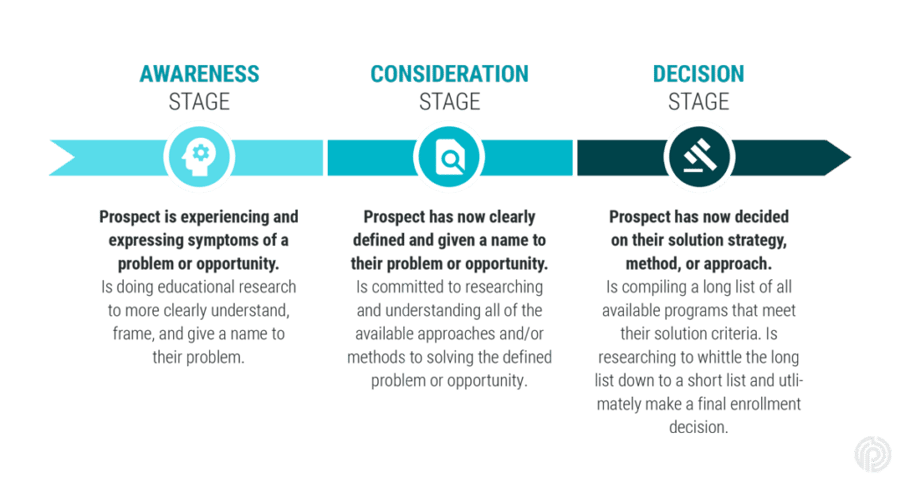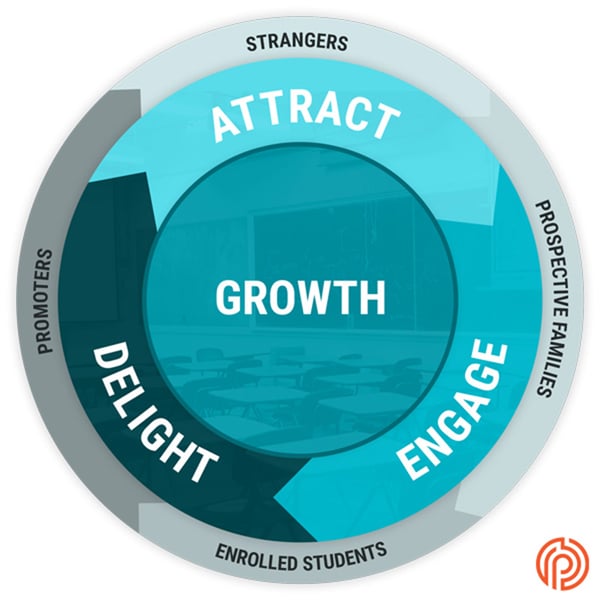
Written By:
Sean Henri

“I know that I’m also speaking for my daughter when I say that we couldn’t be more thrilled with our choice in this school. We’ve felt at home since day one with their team holding our hands throughout the entire enrollment process, long before we stepped foot on campus. Since the earliest moments of us considering a private school, they’ve provided the information and guidance we needed to reassure us we were making the right choice for our child’s education. It was actually the helpful content on their blog each week that first got me thinking about how my daughter could benefit from a switch.”
While this quote is made up, it’s exactly the type of testimonial you want from new families as a result of the right enrollment marketing plan, system, and tools.
If you're not seeing this type of feedback, it’s critical to do some reflection to find out why. A good place to start is to look closely at a prospective family’s current journey compared to what it should look like, along with what role your marketing efforts, people, and systems should be playing in facilitating this ideal experience.
During this reflection, it’s important to remember that marketing shouldn’t begin or end with the inquiry. It also shouldn’t solely focus on “promoting” and “telling people” about your school. While marketing is an effective way to share your school’s unique value proposition and story with the community you want to reach, it should also be a way to offer prospects the same level of personalized attention, care, and advice offered to applicant families.
Marketing as a Guide for Prospective Families
Marketing should act as a storyteller and guide throughout the entire student-family life-cycle with your school. To achieve this, it’s important to consider the different stages of a family’s journey when promoting your school.
The Early Stages of the Family Journey
At the earliest stages of the family journey, resources such as marketing content, customer relationship management (CRM) systems, and your website should act as a digital extension of your team. When used properly, this combination of tools should work together to serve as a guide for families as they make choices about their child’s education and begin to research and compare schools.
If your team isn’t thinking of marketing in this way—only engaging with prospective families from the moment of inquiry and beyond—your school is effectively giving prospective families the cold shoulder during the critical research months before they decide to apply or even schedule a visit. You and your team need to be there to guide and engage families at these early moments—even if you have no idea what their child’s current grade is or the family’s ability to pay tuition. However, these additional efforts don’t need to result in more staff or hours in the day—more on this later.
The Middle Stages of the Family Journey
At the middle of the journey, you'll likely know the prospective parent’s name and a bit about their child, even if they haven’t applied yet. From inquiry through acceptance, families at this stage often receive excellent guidance and advice from the Director of Admission and other key staff. This personalized, human attention is often the tipping point that establishes a strong connection between the prospective family and your school community.
“Once we get them here, the rest falls into place” is a common quote I hear a lot, and for good reason. Your school likely has an incredible story to tell, and once you get to tell it, families are hooked.
The problem comes as the volume of inquiries and applications begin to increase. Suddenly, the amazing personalized attention that was given to just ten or so families each season now has to be given to forty. Despite the increase, with budgeted enrollment remaining flat, your team’s headcount remains flat as well. This creates a workload imbalance. When that happens, your ability to manage the paperwork and process begins to suffer, or the personalized attention you offer prospects begins to scale back to alleviate the workload.
To manage this growing challenge, your team needs support from a mix of marketing content and tools. These resources can be used in a number of ways, but it’s important to consider what tasks steal the most time from you and your team. Some examples you should consider include:
- Instead of manually typing lengthy emails that outline the specifics of your admission process, you should be able to press a button that instantly drafts a perfectly crafted email that’s ready to be personalized and sent in seconds.
- Instead of spending hours telling a single family about how your school fulfills its mission, create an automated email drip campaign that shares this story in advance of your conversation so you can engage in more meaningful, personalized conversations.
- Instead of referencing a complex Excel sheet or a saved database query to figure out who you need to follow up with, leverage a CRM that guides you to your next action automatically.
The Final Stages of the Family Journey
At the end of the journey, marketing needs to once again take a leading role as the enrollment management team shifts its attention toward next year’s cycle. The anxiety parents felt during the admission process once again begins to boil as the first week of school quickly approaches.
Parents begin asking questions like:
- What is the dropoff and pickup process?
- What school traditions should we be aware of?
- What will my child expect during their first day and week of school?
- How can they begin to make friends with their classmates outside of the classroom?
- How can we get to know other families?
Here, marketing can assist by developing automated email campaigns that serve as a “Preparing for your first year at our school” mini-course. Week-by-week, incoming families can learn more about your school community, culture, traditions and policies through these emails, which can increase the likelihood that they’ll have a successful first year. Some schools may choose to send this information in a printed format as well. Unfortunately, these types of automated welcome email sequences for new families are rarely leveraged by school marketers.
As a result, parents are often left to their own devices getting answers to these questions. In absence of guidance from your school, they turn to Facebook groups and other social media channels to search for answers on their own. If they’re lucky, they’ll find an “Information for New Families” page tucked away somewhere in your navigation, but with the amount of information that’s crammed onto this page, they’ll likely leave more confused.
If recruitment of new families isn’t a current concern and retention is a bigger challenge, the same ideas can be applied there as well. Marketing must play a key role keeping families engaged and aligned with the school’s values and mission. Your school’s CRM and marketing software should play a key role in helping you identify potential retention risks. Once those risks are identified, marketing should assist enrollment management teams to facilitate interventions before it’s too late.
By now, you hopefully see the value of guiding and advising families through their decisions with digital marketing. If you’re now convinced that you would like to adopt this practice at your school, your next step is to map out the family journey so that you can best determine what parts of that journey might need guidance. So, what does this process look like in practice? Let's explore further.
Mapping the Student-Family Journey
In the previous section we shared how school marketers and enrollment leaders can adopt a “marketing as a guide” mindset—extending prospective families the same quality and care offered in-person to applicants and current families through digital marketing—in order to improve the prospective student-family experience and see significant improvements in the health of their enrollment pipeline. Here, we explain the first step in embarking on that journey: mapping out the complete journey that families go through when making decisions about their child's education.
In describing the journey a student and their family goes on while researching, selecting, and then enrolling in an independent school, it’s helpful to understand three concepts:
- The Hero’s Journey
- The Buyer’s Journey
- The Inbound Methodology
The Hero's Journey is a narrative framework that is often used by authors, screenwriters, and recently, content marketers. It describes a hero's transformation through a cycle of departure, initiation, and return, often entailing a call to adventure, facing trials, acquiring a reward, and then returning transformed.
When using this framework for marketing purposes, the customer—or in the case of a school the parent’s of a prospective student—is the Hero. To overcome any doubt and develop the skills necessary to be successful, the Hero encounters a guide. Your school’s staff and marketing collateral is that guide.
The Buyer's Journey is a three-stage process that a consumer goes through, which includes the Awareness Stage (recognizing a need), the Consideration Stage (evaluating different solutions), and the Decision Stage (making a selection).

In the context of a prospective student-family journey, the need is understanding that the status quo is not acceptable. The solutions are independent schools and the specific type of independent school they decide to consider. The selection is the decision to enroll.
The Inbound Methodology is a method focused on growing your school’s enrollment pipeline by establishing meaningful relationships with prospective and current student families. It flips the traditional mindset where all marketing and communications are about your school and how great it is that’s focused on their goals and needs. An enrollment professional with an inbound mindset is fully committed to helping the student and their family meet their goals at any stage in their journey with you.

Since the Buyer’s Journey is a simpler model to learn than the Hero’s Journey, we’ll use that for illustrative purposes. That said, the Hero’s Journey can be a fantastic way to have fun with this process and develop a strong sense of empathy for prospective families as they make decisions about their child’s education. For narrative structure, I’ll use this framework in the story down below. However, I recommend using the Hero’s Journey for brainstorming, and the Buyer’s Journey for documentation and process.
Now, let’s take a look at what a journey might look like when an independent school decides to use their marketing channels as an extension of their team, serving as a guide to prospective families.
Awareness Stage: Disruption of the Status Quo

Emma and Mike have started to notice that their son, Lucas, isn't thriving at his current school. His grades have dipped, he complains about feeling bored and uninspired, and he's lost his enthusiasm for learning. Faced with this realization, they begin researching other educational options, including independent schools. They stumble upon your school's blog, where they find a wealth of information on your educational approach, testimonials from satisfied parents, and articles on how to choose the right school for their child.
They download your school's e-book on "Understanding Independent Schools," which paints a clear picture of your school's value proposition and begins to challenge their previous biases. As a result, Emma and Mike start to receive personalized emails sharing stories of students who've flourished at your school, similar to Lucas, further solidifying your school as a possible solution to their child's needs.
Consideration Stage: Crossing the Threshold

As they dive deeper into their research, your school's robust CRM system helps them schedule a virtual school tour, where they’re able to see your school's state-of-the-art facilities and immersive, engaging classroom environments. They attend a virtual parents' evening, where they have meaningful interactions with your school's leadership team, faculty members, and existing parents.
During this stage, the personalized emails continue, offering insights into the curriculum, extracurricular activities, and student life. They also receive an invitation to a private webinar that addresses their concerns around the transition from public to private schooling, financial commitments, and how to ensure a smooth transition for their child. Emma and Mike start to visualize Lucas as a part of your school community.
Decision Stage: The Approach to the Inmost Cave
Emma and Mike decide to apply to your school. As part of the application process, they engage with your school's digital checklist that makes the process feel easy and well-organized. As they work through the application, they receive regular email updates keeping them informed on the progress of their application and any additional steps they need to take.
Once accepted, they’re introduced to a community liaison—a current parent—who welcomes them to the school and offers to answer any questions they have as the new school year approaches. This creates a sense of belonging to the school community. They also receive a welcome kit with school merchandise, important contact information, and a handbook of school traditions and procedures.
Additionally, they are enrolled in an email series providing comprehensive orientation information. This includes the school's values and ethos, traditions, academic expectations, dress code, drop-off and pick-up processes, and more. By the time Lucas starts his first day at your school, both he and his parents feel informed, prepared, and excited about the journey ahead.
First Year: Transformation and a New Normal
The first day of school arrives. Lucas is a little nervous but excited to embark on this new journey. As Emma and Mike drop him off, they are comforted by the welcoming smiles of the school staff and other parents. The seamless drop-off process they learned about through their orientation emails plays out smoothly in reality, and Lucas is swept into his new class with ease.
Throughout the first weeks, they receive regular check-in emails from Lucas's teacher, including updates on his academic progress, social integration, and overall well-being. These updates offer reassurances and suggest areas where they could support Lucas's transition at home, making them feel like an integral part of their son's educational journey.
The school's CRM continues to work in the background, delivering relevant email content to Emma and Mike, including upcoming school events, opportunities for parent involvement, and resources to support their child's learning at home. They also receive invites to parent-teacher meetings and family social events, further nurturing their relationship with your school community.
A few months in, they're invited to contribute to a satisfaction survey which gives them the opportunity to share their experiences and offer suggestions for improvement. This allows your school to identify and address any potential issues early on, ensuring continued satisfaction and retention.
Halfway through the year, they receive a personalized report of Lucas's progress, highlighting his academic achievements, involvement in extracurricular activities, and personal development. Alongside the report, there's an invitation to a parent-teacher conference, where they discuss Lucas's achievements and goals for the next term in detail. As a result, they leave feeling proud and confident in the decision they made to enroll Lucas at your school.
As the school year comes to a close, they receive an end-of-year review, featuring the highlights of the school year, significant school-wide achievements, and a preview of what to look forward to in the next academic year. The cycle of communication continues, keeping Emma and Mike engaged and assured that they made the right choice for their son's education.
Lucas's transformation throughout his first year is evident. He is thriving academically, developing a close circle of friends, and rekindling his love for learning. Emma and Mike are now more than satisfied parents; they are active, enthusiastic advocates for your school within their network, sharing their positive experiences and the significant transformation they've seen in Lucas.
The Journey Ahead: Embracing Marketing as a Guide
The transformative journey that Lucas and his family experienced wasn't simply due to the high-quality education your school provides; it was also the result of strategic, empathetic, and proactive marketing that positioned your school as a guide and mentor. From the initial exploration phase, through the decision-making process, and into the first year of enrollment, your marketing efforts played an invaluable role in fostering a deep sense of connection and trust.
As school marketers and enrollment managers, you’re not just promoting your school; you’re facilitating a journey. You’re guiding families from uncertainty to confidence, from anonymity to community, and from potential to achievement. The tools, technology, and tactics you utilize are merely extensions of your commitment to guide each family through their unique educational journey.
Remember to reflect on your current practices. Ask yourself:
- Are you truly serving as a guide for prospective families from their first interaction with your school?
- Are you leveraging your CRM and marketing tools to their fullest potential to deliver personalized and proactive communication?
- Do your current efforts extend beyond the point of enrollment, ensuring a seamless transition into the school community?
If the answer is no, it's time to take action! Transform your marketing strategy from a simple promotional vehicle to a comprehensive guide and mentor. As you do, you'll not only fill seats, but also build a strong, engaged community of families who are invested in your school's vision and mission and, ultimately, become ambassadors for your school. Their stories, satisfaction, and loyalty will be the most powerful testament to the value your school provides.






